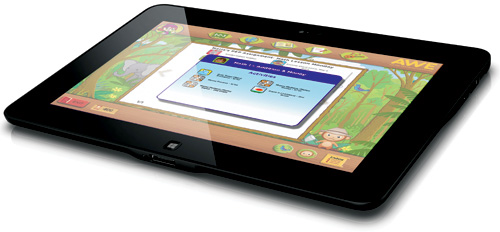
You stop by your neighbor’s classroom. The kids have spread out all over the place, each with a tablet computer in hand. Some tap furiously at their screens, dragging, dropping, and matching questions and answers. Others are typing. Some read. Here and there, a pair of students lean over a shared tablet, pointing out and manipulating parts of an art project or movie.
This is a scene out of both the present and future of public education, depending on where you are, and it’s one in which AWE Digital Learning Solutions wants to play a role as a provider of “all-in-one” solutions facilitating the spectrum of work going on.
Figuring out and planning what kids should learn with tablets—and how they should learn it—is a complex task that has engendered all sorts of debate among educators. When do we want kids to consume content, or produce something instead? How much time should we be spending on screens, as opposed to making something ‘real’ at the table or outside the classroom? What should we prescribe for kids—and what should they explore on their own? Is there a useful difference between work and play, as long as kids are learning?
The AWE tablet is one attempt to answer all those questions at once. How well it does so largely depends on how teachers use it in the classroom.
What is the AWE tablet?
The AWE tablet is a mobile, hand-held version of AWE’s “all-in-one” educational workstation. In pursuing its mission of creating lifelong learners, AWE sells devices that package a wide variety of discipline-area activities for three age groups: preK, grades K–3, and grades 4–6. Each AWE tablet ships with a very responsive stylus, as well as a thin, hard-case cover for the back of the device. AWE offers a purchase as well as a subscription pricing model, along with quantity discounts. External keyboards are available for an additional cost.
AWE’s approach to lifelong learning relies on pairing individual kids with the content-area work through personalized learning plans accessible via their workstations—and, now, the AWE tablet. This blended-learning approach depends on the quality of the plans prepared by the teachers, as well as the curation of content on each tablet.
The tablets themselves are lightning-quick Dell machines running AWE’s “browser” that presents and sorts the instructional package installed by AWE. These are not tablets for surfing the Internet or learning to code. They are solid, traditionally oriented learning tools that kids can take to their favorite classroom perches to access personalized curricula. This isn’t the only tool you’d need in an inquiry-focused or production-centered classroom, but it can anchor content-driven practice and meet classroom needs for a productivity suite through its included Libre Office package. Many other AWE tablet’s apps are also available.
What can educators do with it?
Teachers can use the AWE tablet for facilitating prescriptive, collaborative, or explorative work in the classroom. Using the AWE Customer Portal and admin tools on the tablet itself, teachers can write personalized education plans (PEP) for students. They can also sort, select, and assign specific apps, as well as lessons within those apps, to individual students. Tasks can be sorted, grouped, and sent to kids’ tablets by content, grade level, and skill. Furthermore, teachers can create and save whole-class, small-group, and individual “play lists” of work to broadcast to as many tablets as they’d like. Bundled apps include a number of popular literacy and numeracy aids (like JumpStart) and, to a lesser extent, content for the arts, history, and science. Teachers can control the session duration for each tablet in order to time kids’ responses to their assigned work or end a session to prevent eye-strain or overuse.
However, teachers cannot add apps to those put on the tablet by AWE. This tablet is not for Internet deep dives or cutting-edge coding or media production apps. It does include a number of kid-friendly art, movie, and music programs, but student work will be defined by what each app allows, rather than by what teachers and students can imagine making together.
That doesn’t mean that the AWE tablet couldn’t be useful in a very production-centered classroom. It just means that in such a classroom, this tablet might play more of a niche role in an independent-practice or skills-building station. It could support the development of foundational skills helpful in more in-depth research and production projects.
The AWE customer portal, which synchronizes PEPs and student-use statistics, also lets teachers monitor student use and progress.
Key Concepts For Technology-driven Classrooms
• “Blended Learning” (Wikipedia)
• The Maker Education Initiative
• “One-to-One Computing” (Wikipedia)
• Production-oriented learning (EduTechWiki)
• “The Best Device is a Good Teacher” (Edutopia)
How can kids best use the AWE tablet?
What students can do with the tablet is very much controlled by their teachers. They can use it to complete practice activities that you assign—or, in some cases, to explore, play, and learn through the apps that most appeal to them. If you’re looking to foster exploration and inquiry alongside compliance and safety, you’ll have to be very intentional about how you frame kids’ time with AWE’s tablet.
Bottom line
The AWE tablet is a fast, dependable device for delivering blended content-area practice to individual students. It’s a robust organizational tool for assigning and tracking blended work. Before purchasing, you should think about how such a device can play a meaningful role in your school or classroom, and how it can support kids in becoming those life-long learners—inside and outside blended environments—that AWE hopes to foster. This tablet works best as a launch pad or touchstone instead of an instructional end in and of itself.



Seems to be a great device! It’s interesting if it’s all the same inside as other AWE systems.
We just switched from AWE to Magic Desktop (http://magicdesktop.com/) in our library.
And it turned out to be a much better solution for us.